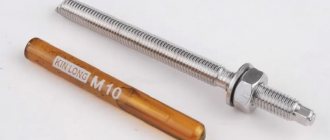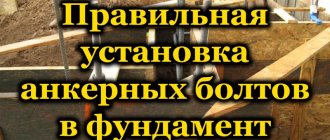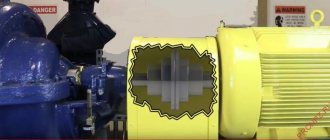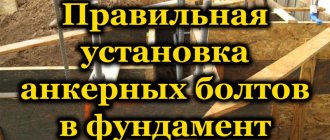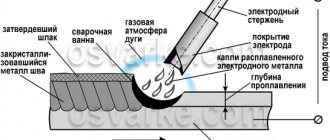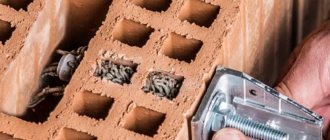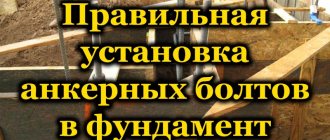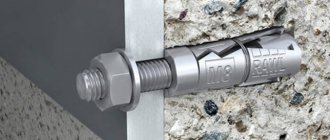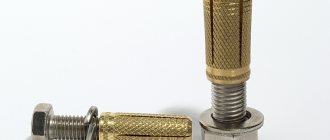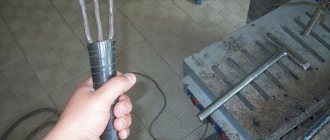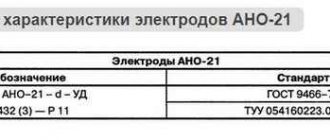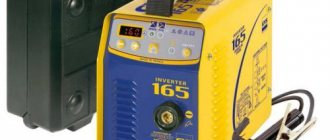Obviously, each of these materials has its own pros and cons. Steel anchors, which demonstrate high mating strength, cannot be used in conditions of high humidity and chemically aggressive environments. Galvanizing, along with extending the full service life of steel fasteners, increases their cost.
Stainless steel materials are not subject to corrosion. In addition, steels A3, A2 and A1 have high strength. However, all these advantages are offset by the increasing cost of final products made from these materials.
The strength characteristics of brass are not the best, but they are preferred when the anchor bolt with hook will be used in an environment with high humidity.
Mechanical anchors
Mechanical anchors are typically used to connect three-layer masonry layers, façade elements, steel structures, or to connect structural elements to lintels and caps.
These anchors are also chosen for creating flexible connections of working structural elements, as well as where the fixed element is subject to high mechanical loads.
Mechanical anchors can only be used on solid foundations, mainly concrete. They have great strength, therefore they are intended primarily for installing elements that create very high loads.
Installation of mechanical anchors depends on their type and substrate. The most common mechanical anchors are:
- Sleeve;
- Drivers;
- Wedge;
- With ring or hook;
- Double-expansion: with an anchor sleeve and internal thread, they work by increasing the attachment point through the expanded sleeve when tightening the wedge.
Anchoring of building structures
Anchor elements ensure the transfer of the load from attached objects to the anchor base, which can be a load-bearing or non-load-bearing building structure.
A wide range of natural and industrial materials can be secured with anchor bolts. The load on the base can be static or dynamic.
The environment in which anchor elements are placed also has a fundamental influence on their selection in terms of influencing the material of the anchors, whether they are embedded in the structure or located in an open space, air gap.
Attaching objects can be done in two ways.
- Having secured the anchor bolts in advance;
- Additional fastening of anchors.
Anchoring can be done in bricks, concrete, metals, plastics and wood. For these purposes, materials can be divided into groups according to the cubic capacity of the material:
- With low cubic strength below 10 MPa. Such materials include solid brick masonry, hollow brick masonry, plasterboard, foam concrete;
- With cubic strength from 10 to 50 MPa. These materials can be used to remove and install anchors with high load-bearing capacity. This group includes high-strength brickwork and concrete;
- Cubic strength more than 50 MPa. Installation of anchor bolts in such structures is impossible.
Fastening to plastic and wood is carried out by a simple technology of hammering various nails manually or pneumatically. Another way is to drill out the screws.
Types of anchor bolts and areas of their application
A fastener such as an anchor bolt is presented on the modern construction market in various designs. Along with universal fasteners of this type, manufacturers produce anchor bolts designed to solve highly specialized installation problems.
In order to choose the right fastener of this type, it is necessary not only to have a good understanding of its varieties, but also to know what types of anchors are used in certain cases. Let's consider the most popular types of anchor fasteners, their scope of application and the validity of their choice in a particular situation.
With a nut
This is the simplest anchor, consisting of a threaded rod with a conical lower end, a spacer sleeve with longitudinal side slots and a nut, with which such a bolt is fixed in the mounting hole. The principle of operation of such a fastening device is quite simple: its entire structure is placed in a pre-prepared hole, the diameter of which must correspond to the transverse size of the spacer sleeve; when the nut is tightened, the threaded element begins to be drawn into the hole of the spacer sleeve, spreading it apart with its conical tip. Thus, the spacer sleeve, which has increased in diameter, ensures reliable fastening of the anchor bolt in the mounting hole.
Anchor bolts are made from various steels for fastening in dry places, with high humidity and for use in aggressive environments
Modern industry produces anchor bolts equipped with a nut in a wide range of sizes. Thus, the minimum diameter of such fasteners corresponds to 6 mm, and the maximum can reach up to 28 mm. As for the length, it can be in the range of 60–300 mm. When choosing such an anchor, you should keep in mind that it will be effective only in cases where fastening with its help is carried out in building materials with a dense internal structure (this includes concrete, natural stone, solid brick, etc.).
With hook
An anchor bolt of this type differs from the previous one only in that its upper part is crowned not by a straight threaded end, but by a hook, which makes it easy to install various attachments. The nut, also used in the design of such an anchor and located directly under its hook, is necessary only to ensure the expansion of the spacer sleeve and, accordingly, its reliable fixation in the wall or any other building structure.
Technical parameters of hook anchor bolts (click to enlarge)
The main convenience of this anchor bolt is that the object attached to its hook can be removed at any time if the need arises. Anchors of this type are most often used for mounting lamps and chandeliers, attaching water heaters and other household devices to wall surfaces.
With ring
This anchor differs from the previous one in that its upper part is crowned not with a hook, but with a ring or half-ring. Moreover, the principle by which it works is similar to the action of anchor bolts of the two previous types. The ring that ends the upper part of such fasteners is very convenient to use for mounting various objects and structural elements.
The anchor bolt with ring is protected by a white or yellow anti-corrosion coating
The dimensions of the structural elements of the anchor bolt with a ring can be different. It is successfully used for hanging various objects on ceiling structures; with its help it is very convenient to perform various stretches, attach cables, chains, cable routes, scaffolding, etc.
Double-spacer
Such anchors differ from conventional expansion anchors in that their design contains two bushings at once, which expand during the process of tightening the threaded element. The principle of operation of double-spacer anchor bolts is that when the screw is tightened, one of the spacer sleeves enters the second, spreading it apart. In this case, the first bushing into which the screw is screwed is also unclenched. Due to the larger area of adhesion to the walls of the mounting hole provided by such an anchor bolt, it can be used for installation in porous and even hollow building materials.
Types of double-expansion anchors
Wedge
Wedge-type anchors, due to their high cost, have not found widespread use either in construction or during repair work. Their price is explained by the complexity of their design, which can be assessed even from the photo. When screwed, the screw of such an anchor bolt acts on a wedge element that moves freely along the inside of the hole in the spacer sleeve. It is the latter, exerting pressure on the spacer sleeve from the inside, that ensures its maximum expansion.
The wedge-type anchor bolt is considered a modernization of the standard anchor.
Driven In
, it is not the screw that is responsible for loosening the spacer sleeve of the anchor bolt, the design of which is fundamentally different from the design of all of the above, but a special impact device, which is often simply called a nail. The process of attaching such an anchor to a building structure is as follows. Only a bushing is placed in the mounting hole in the building structure, which is expanded by applying a special impact element to it. After the spacer sleeve is securely fixed in the hole, the impact element is removed from it and a bolt or pin is screwed in instead, onto which the object being fixed is hung.
Dimensions and parameters of drive-in anchors (click to enlarge)
With hex head
The main element of this type of fastener is a regular bolt, which is inserted into a cone-shaped hole in the spacer sleeve. By expanding the hole, the anchor bolt thereby expands the petals of the spacer sleeve, ensuring its reliable fixation in the mounting hole. A variety of such fasteners are anchors, on the top of which there are slots for a Phillips screwdriver. Taking into account the fact that a screwdriver cannot provide the same force as a wrench, anchors of this type are made only in small sizes (their diameter, as a rule, does not exceed 12 mm).
Parameters of hexagonal anchor bolts (click to enlarge)
Thus, there are a variety of types of anchors on the modern market. The main requirement for them is high reliability of fastening, so they should be selected taking into account not only the size and weight of the object being fixed, but also the strength characteristics of the building structure material and a number of other parameters.
Pre-attached anchors
Early fastening of anchor elements in parts of structures occurs already at the stage of constructing the supporting structure, as in the manufacture of a monolith on construction sites or prefabricated factories.
The anchor elements secured in this way are ideally connected to the supporting structure and have high mechanical strength and resistance to dynamic loads. Pre-fixation of anchor elements has many possible solutions.
Suspended Assembly - In this method, the anchor bolt is usually flush with the structure. Through installation - reduces labor costs when frequently reusing anchor elements or objects with multiple attachment points. The holes in the attached object can be used as a template for a loop anchor bolt.
- Remote fastening - used for fastening structures that are mounted at a certain distance from the anchor base.
- For this purpose, metal anchors with external threads are used, which hold threaded rods or screws with locking nuts at the required distance.
Most often in such structures, anchors with a nut are used.
Due to the need to know the exact position of the anchor point in advance, the design of pre-attached anchor elements is more demanding on the base and on site installers' approval.
Applications and advantages of anchorage
The product functions as a dowel and performs similar functions and is used for fastening into both solid (concrete, stone) and porous supports. But, thanks to its design features, it has a number of advantages:
- the highest level of load-bearing capacity compared to other hardware;
- a variety of standard sizes makes it possible to choose the optimal type of anchor for any design or material;
- For the manufacture of the anchor system, corrosion-resistant, especially strong steel is used, designed for a long service life;
- simple, skill-free installation;
- the possibility of additional strengthening of the existing structure;
- increased resistance to static, dynamic and even vibration loads.
Double spacer anchor bolts
Such anchor bolts can be inserted into the structure during the manufacture of the structure or directly on the construction site. Since they act as formwork, the bolt must be assessed during design taking into account the chemical composition of the concrete, the aggressiveness of the environment, the risk of water vapor condensation, and the type of screw.
If double-expansion anchor bolts are used incorrectly, the concrete can crack, especially around the sleeve on the tapered surface. The height of the concrete cone is determined by the anchorage depth of the concreted anchor sleeve.
Additional anchor bolts
Additional fastening of anchor elements is currently a more common type. It is used in cases where it is impossible or impractical to predict the position of anchor points.
Additional secured anchor bolts are inserted into the material, hammered or hammered into the drilled holes. Here they are fixed by friction caused by the anchor fixing in the base material, or by gluing, or using silicate-based binders.
Two factors are decisive for the correct choice of anchoring method [2]:
- Size and type of load acting on the anchor;
- Properties of the material in which the anchor element is fixed.
The dimensions of the anchor bolts are determined taking into account the readiness of the joint to transfer loads, the location of the joint in a certain environment (aggressiveness, temperature, water vapor condensation), and the mutual reaction of the base material and the anchor.
For any type of bolt anchoring, it is better to use products from well-known manufacturers who provide a guarantee on hardware and control the manufacturing process at all stages. The price of anchor bolts in such cases is usually higher, but this pays off in durability.
Specifications
The accompanying documentation for any anchor bolt, including those with a hook, must indicate the maximum load that it can withstand. But the working value of this parameter should be four times less than its declared value. This requirement applies to the case when the material for the mounting base is concrete with a density ranging from 200 to 250 kgf/cm2.
For concrete characterized by a different density, the maximum and working loads are recalculated proportionally. If there are bases of cracks in this material, a different approach is practiced. Then the load should not exceed 0.6 of the standard load.
The main technical characteristics of an anchor bolt with a threaded rod ending in a hook are presented in the table.
| Standard size | Anchor length, mm | Pull-out force, kgf | Estimated weight, kg/1000pcs | Hook length, mm |
| M16×110 | 95,0 | 47,3 | 202,2 | 45,0 |
| M16×80 | 66,0 | 183,0 | ||
| M16×60 | 46,0 | 151,0 | ||
| M14×100 | 89,0 | 40,0 | 130,0 | 40,0 |
| M14×70 | 59,0 | 110,0 | ||
| M12×130 | 121,0 | 34,6 | 134,0 | |
| M12×100 | 91,0 | 116,0 | ||
| M12×70 | 61,0 | 99,0 | ||
| M10×120 | 113,0 | 24,8 | 81,0 | 35,0 |
| M10×100 | 93,0 | 70,2 | ||
| M10×80 | 73,0 | 59,2 | ||
| M10×70 | 63,0 | 55,2 | ||
| M10×60 | 53,0 | 51,2 | ||
| M10×50 | 43,0 | 46,5 | ||
| M8×100 | 95,0 | 13,4 | 43,5 | 33,0 |
| M8×85 | 70,0 | 37,0 | ||
| M8×60 | 55,0 | 29,5 | ||
| M8×45 | 40,0 | 24,0 | ||
| M8×40 | 35,0 | 22,5 |
